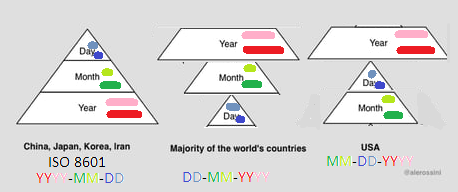Actual poster from 1917 that made me laugh. A lot.
Also, those motherfuckers are measuring the weight of those balls in kilograms, aren’t they?
The more I read about America, the more I realise what a fucking stupid country it was, is, and will probably keep on being.
There are some pretty smart people in America tho
Indeed, too bad nobody wants to listen to them
If I could read, I’d probably be insulted by this comment.
Hence the effort to defund education.
As if people weren’t so fuckin dumb already.
Christ WTF year are we fucking in you guys?
How awful. Making someone divide things by 10 instead of 12, 16, or fucking 64.
Poster shows the metric system giving Uncle Sam giant balls of steel?
Imperial emasculates.
From John Bazell “In metric, one milliliter of water occupies one cubic centimeter, weighs one gram, and requires one calorie of energy to heat up by one degree centigrade—which is 1 percent of the difference between its freezing point and its boiling point. An amount of hydrogen weighing the same amount has exactly one mole of atoms in it. Whereas in the American system, the answer to ‘How much energy does it take to boil a room-temperature gallon of water?’ is ‘Go fuck yourself,’ because you can’t directly relate any of those quantities.”
There’s a popular argument against religion that essentially says that if any trace of a specific religion were wiped off the face of the Earth, it would never come back. As in there’d probably be something in its place, but there’d no way that the specific beliefs practiced by that religion would ever return. Whereas if a piece of scientific knowledge were similarly wiped from human knowledge, it would eventually be rediscovered.
A similar argument can be made with the metric system: I think that if standardized measurement systems disappeared from the face of the Earth today, something extremely similar would eventually be invented and adopted. It’s just too internally consistent and human mental math too grounded in decimal for it not to be. You’d probably even end up with a prefix-based (probably even Greek) naming scheme.
Now consider USC: the units fail to fit together in basically any meaningful way. They try but fail to be base-2, so you can’t even come at it from the already-tenuous angle of base-2 being better than base-10 (e.g. volume skips what two quarts would be, weight is more like base-16 (???), and distance just does something so insane that probably 95% of American adults couldn’t tell you how many feet there are in a mile). There are dozens of completely arbitrary, unintuitive, antiquated-sounding names (e.g. “horsepower”). Although the bases for metric measurements are rather arbitrary, they are extraordinarily precise, so much so that USC bases its own measurements off of insane but precise multiples of metric units. That’s not to say that humans would jump straight to metric or anything, but moreso that whatever would fill USC’s role as an intermediary between nothing and the metric-like system would likey be unrecognizable from current USC.
The “intuitiveness” of imperial measurements is that they’re sorta human-scaled, at least for human-sized measurements. An inch is about the same length as the tip of my thumb, a foot is about as big as my foot, a yard is a single pace if I stretch a bit, etc. which makes it easier for a person to picture it.
Once you get out of that scale it really starts to break down though.
Yeah, the thing is that I actually don’t terribly mind feet, cups, etc. as individual measurements. Taken alone, they feel intuitive. The first of two main issues is, as you mentioned, scale. And you could make the argument that you could just take the base units like feet, cups, etc. and decimalize them with prefixes. And that does alleviate a ton of problems with USC, but you also then run back into the issue of unit intercompatibility.
Metric units have quite an elegant and intuitive interplay that USC simply lacks. What’s a liter? Why it’s a cubic meter. But now if I try to relate USC volumes to cubic USC distance measures, things quickly fall apart. A gallon is 231 cubic inches exactly, which is a whole number, sure, but that’s terrible for intution and for scaling. What’s a kilogram? Why it’s the mass of a liter of water. If you try relating pounds to units of volume, you might settle on one pound per pint, but that isn’t true, as it’s actually 1.041 pounds. So while it works at that scale, it quickly begins to fall apart and becomes completely inintuitive.
So unfortunately, even if we introduced intra-unit scaling by choosing one base unit and scaling that, working with USC would still be a nightmare when trying to intuit between different units. And this is, of course, not including things like horsepower that may have been intuitive 150 years ago but now are almost exclusively used 1) at minimum in the hundreds and 2) by people who have literally no concept of how much a horse can turn a mill wheel.
Calorie? Are they part of metric system? Everyone uses Joule.
Calories are metric but not SI.
… weighs one gram … An amount of hydrogen weighing the same amount has exactly one mole of atoms in it.
Not only was this never true - the sentence would have to have say “An amount of carbon-12 atoms weighing 12 times this amount has exactly 1 mole atoms in it” (far less elegant) – but not even this is true any longer after the fuckup in redefining the mole in 2019, after which all these relations between amount of substance and mass are only approximate.
the fuckup in redefining the mole in 2019
What? It was necessary due to our observations of the universe (on every scale), not some subjective “fuckup”
Nope, this redefinition isn’t necessary, it is a choice SI made. Nothing would have broken by keeping an exact relationship between amount of substance and mass, it would just have retained the interpretation of Avogadro’s constant from before 2019 (experimentally determined vs a defined constant).
But we’re supposed to use Joules, not calories
I believe the calorie is a derived unit while the Joule is a base unit.
Somebody correct me if I’m wrong.
The calorie used to be the base unit, until we released in the 19th century “wait, heat isn’t a gas” and threw out caloric theory, and made the joule. Now the calorie is defined as 4.184 joules.
Yes, you’re right.
There have been multiple iterations of the “metric system” since it’s introduction in 1792–1795, most notably the original 1795 draft variant, then the CGS (Centimeter-Gram-Second) version, then the MKS (meter-kilogram-second) variant, with the most recent incarnation being the International System of Units (SI).
That’s why there are plenty of metric units, but not all of them are SI units. :)
Edit: Changed “1892–1895” to “1792–1795”. Lol, whoops.
It’s demonstrative anyway
I mean, 1btu is required per pound of water per degree Farenheit. About 8lbs/gal and raising it 142°f would mean 1136btus
Just remember to keep track of which BTU you’re using
Lol also which gallon for that matter
Removed by mod
What ‘has’ we done. Well, they didn’t go to school, that’s for sure. And clearly they didn’t send their kids to school either, as it’s a damn old poster and it’s been more then a hundred years while the US still uses imperial.
There is literally a W right over that H to compare it to.
Yeah, I down voted my own comment.
Kudos for leaving it up.
The US Government is entirely metric. It’s just the US Citizens that aren’t. So there’s this entire separation where no one uses metric, so nothing is made for metric, since nothing is made for metric, no one uses metric.
Obviously that’s changing over time plenty of people use a mixture of both systems all the time. The machines are mostly driving adoption at this point. 3D printers, cars, etc.
How many centimeters in a kilometer?
How many inches in a mile?
Strange how you can easily work out the former, but the latter could be anything from 28 to 56285794
🤔
American answer: “Shut up, Euro-freak. I’m trying to watch Big Bang Theory reruns.”
The medical system ended up using the metric system anyway
America has medical system?
Nope, that’s why they didn’t duck up with it
As an American who lives and travels on a sailboat, it’s sooooo much easier to just be normal and think in metric.
Foreigners (who aren’t sailors) are always amazed when they meet an American that can speak metric.
Why the US refuses to get in bed with the rest of the world is beyond me. Stupid AF I guess …
It’s possible! We can switch! I’m US born and raised and I voluntarily switched to metric in college. It took me maybe we few months to start building an intuition for Celsius, grams, liters, and meters. And that was with me in isolation. I would imagine it would be much faster if everyone else was also transitioning.
Over the years, other people have asked me about this and I’ve been shocked at how many people don’t realize most of the world uses metric. Someone asked why I was using “Mexico units” once… Also, I’ve met lots of people who think the US invented inches, pounds, etc, which is… uh… interesting. The arguments y’all are having here are way more advanced than what I’ve run into.
For anyone who wants to voluntarily switch, I highly recommend not to convert between imperial and metric. Just read the metric number and that’s it. The weather says it’s 25c outside? Don’t convert to F. Go outside, experience 25c. Over time you’ll build an intuition. Smartphones and computers have made the switch easier these days.
Of course, until we all switch you’ll really end up being bilingual…
For me it was particularly easy as it’s only Chevy and Ford cars that still use the imperial system for nuts and bolts so I’ve been making use of the metric system for pretty much every car I’ve worked on and I never really understood ferinhight to start off with as I only really cared about is it going to snow temperature wise so why memorize a number for something your only going to check one time in the year now that I’ve gotten accustomed to Celsius I’m now paying attention to if it’s going to rain or not
It’s also helpful to remember that water boils at 100C and your body temp is about 36-37C. Helps me when I see the weather or something.
Room temp is ~21 degrees. That helped me a lot.
We actually were transitioning to metric when Carter was president and making progress. We did a lot of dual markings like highway signs, weather reports, etc.
The we ejected Reagan. And metric is used for pop and drugs.
Drug dealers just know what units system is superior
Of course, until we all switch you’ll really end up being bilingual…
Biunitated?
I stopped caring about British units in 1776! Metric all the way, baby! 🇺🇸 We decimalized their dumb ass currency and we need to finish the job with weights and measures! A vote for imperial units is a vote for red coats! Vote for me for President and I will liberate us from British tyranny! 🇺🇸🇺🇸🇺🇸🇺🇸 🦅🦅🦅
Lab rat here. I got you fam! Let’s collectively believe that BTU’s are real!
Wait…
Metric is just easier and the founders of the US actually considered it but wars -obviously- distracted them from switching to it.
Try farming in Canada. I will actually use liters per acre as a unit to measure in liquid fertilizer into a sprayer, spray it at gallons per acre and drive the sprayer at kph with a pump pressure in PSI on a field that was surveyed in rods.
And you have to do it in two languages too.
Well, chances are the Quebecers will have to learn English because I think ag equipment is exempt from dual language laws. At least I’ve never seen a part number for French manuals.
This is among the dumbest internet arguments ever.
G20/G21. The machines don’t care, my digital calipers, micrometers, rulers, and 3D CAD software don’t care which system is being used. So why should I have my undies in a bunch about which is better? I use the measurement system best suited for the task at hand - whether that’s metric, US customary, or light years.
As for not knowing how many inches are in a mile, that’s about the stupidest internet point ever. No one cares about that, well maybe some civil engineer might need to very rarely care in some unusual situation. The scale of measurement is wrong for inches. In fact, most people don’t care much about the actual distance away something is, they mostly care about how long does it take to get there. The odds are pretty good you have no idea how far it is from your front door to the grocery store in miles or kilometers. But you DO know how long it takes to get there. Whether by foot, bike, bus, or car.
The machines don’t care.
That’s people making the dumb mistake of using the wrong units. They could have just as easily used the wrong metric units.
A second piece of code that read this data assumed it was in the metric unit—“newtons per square meter"
Yes… Code doesn’t write itself.
The machine running that code cares about the definition of the units in that code.
Machines do care.
Machines don’t care about shit, they blindly do what they’re told. Garbage in, garbage out.
I’ve designed and built those machines. We don’t care. Pick the proper units for the job and go at it.
You’ve built an interplanetary spacecraft!? Do go on…
Oddly enough I have helped build a couple of items that flew on the space shuttle back in the day. Which is more than you can say. But most of my work involved industrial machines for manufacturing lines and associated custom tooling. I have machines all over the planet.
OK. So on projects with international teams you always picked metric?
What are the circumstances that would give imperial units an advantage?
You make projects to the buyers specs. But I have made US Customary machines and parts as requested by companies in India, Pakistan, and Great Britain if I remember correctly, (I’ve been out of the business for a good while and I’m now retired altogether). I can’t remember anything in Germany or Japan. The Chinese were always whatever dope dreams they were on that particular day. They could be particularly bad about mixing and matching units for no reason or just making something up out of thin air.
Let’s see, just off the top of head, US thread patterns are a bit better the the metric ones. While it doesn’t mean as much these days thanks to CNC and G20/G21, (because the machines don’t care). The inch pattern of threads are a little bit stronger, (it’s not a whole lot more), and due to the threads per inch standard, it’s easier to just count the number of threads over a set distance, (1 inch), vs trying to measure a thread crest to crest. This makes identifying threads pitches easier with inch pattern threads when trying to make repair parts. And back when manual machines ruled the shops, inch pattern threads made screw cutting lathes smaller, simpler, and cheaper than metric lathes. You needed fewer gears and shafts, fewer bearings, and less cast iron to make the head stock. This made US lathes faster and cheaper to make and cheaper to buy. Plus you can cut more different thread pitches on an inch pattern lathe vs a metric lathe due to not needing to resort to removing covers of the metric lathe to make gear changes and even swapping to a different threading dial despite the QC gear boxes.
These small cheap lathes is why, in their own small way, during WW2 the US industrial capabilities grew so fast. Anyone could buy a small lathe for a few hundred dollars, literally carry it up to as second story flat and start making all those small parts for the war effort. Small benchtop lathes were manufactured by the tens of thousands and they were all bought by people, many of whom had little to no experience in manufacturing to start making extra money in their off time from their day jobs. And while many got worn out and scrapped over the years, you can still find those little South Bend, Clausing, and Atlas lathes in hobby workshops in the US today. And they are lovingly used and doted over by their owners.
US Customary Units are slowly and surely fading into the sunset. And at some point they will just organically fade away, (it’s why there has never been a national law forcing people to switch), as the casual US population just starts using them more and more. We already use the metric system to buy soda and whisk(e)y to searching for that missing 10mm wrench just like every one else on the planet. The only places you still see US Customary units being commonly used is in construction, (inches and feet), travel distances, (miles), and temperature, (Fahrenheit). Construction has backwards compatibility issues making it very difficult to switch from using a 2"x4" to a 50mmx100mm piece of lumber. Not to mention plumbing problems. And distances and speed limits on a road sign don’t really make a lot of difference in how they are shown for the average traveler. And for deciding just how to dress for the weather, what units you are using really doesn’t matter. (Why doesn’t the metric world use Kelvin to measure the temperature in daily use?) It’s not the first time a measurement system has been eclipsed in human history and even the metric system likely will get replaced by something else in the far future. In the end, neither system is head and shoulders better than the other. Nor have I ever claimed such. They both are, after all, just arbitrary units made up by some random dude hundreds of years ago.
G20/G21…
US thread patterns are a bit better the the metric ones
Very interesting. Not directly related to measurements but a clear practical reason to chose imperial over metric. Cups are also a more convenient measurement for dry, equally dense ingredients.
neither system is head and shoulders better than the other
Metric having intersecting definitions (1l of water = 1kg) and being divisible by 10 have clear advantages for mental arithmetic. But if imperial were consistently base 12 I could be convinced to swap.
Why doesn’t the metric world use Kelvin to measure the temperature in daily use?
It sort of is. At least the scale is the same. Only the base value differs.
Weird how you think inches are only used for long distances and not, for example, making sure a beam is the right length while you’re building a house, or making sure a screw is the right size.
But I do agree that inches are not practical for long distances. That’s probably why people in the U.S. use miles.
Millimeter are not practical for measuring long distances either. And measuring the length of a piece of lumber isn’t a “long distance” either
That is why kilometers are used for long distances in metric. I’m really not sure why you don’t know about how people measure long distances.
I do and perhaps more than you. I don’t know why you brought your point about inches and scale when I had already pointed out that those who think it’s such a “gotcha” argument are wrong and why.
Again, use the measurement system and units best suited to the task at hand. And never forget, every measurement system is just a bunch of made up units by some random dude and then modified by some other random dudes at random times.
Oh yeah? I bet you also use mebibyte instead of megabytes!


I believe in some countries in the world, the year goes first, then the month, then the day (2024/08/08 or 2024, August 8). Seems more logical to me than the literal inverse (08/08/2024 or 8 August 2024).
But yeah, the metric system reigns supreme.
I would’ve mentioned it but I forgot what it’s called. Thanks for reminding me.













